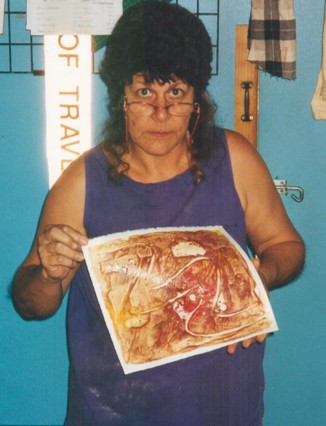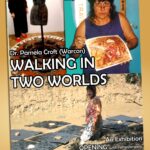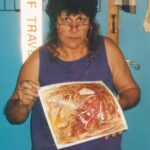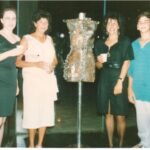A Story of Resilience and Triumph
The story of Dr. Pamela Croft is one of extraordinary resilience. While known for her innovative artwork, it is her journey of overcoming profound adversity that truly defines her remarkable character.
Early Struggles: The Stolen Generations
As a child of the Stolen Generations, six-year-old Pamela was forcibly removed from her mother by government authorities due to her lighter skin color. She was placed with a strict, deeply religious white couple who raised her under harsh conditions, where even minor infractions resulted in punishment. Any expression of interest in her First Nations heritage was actively discouraged, and she faced additional bullying and isolation at school.
Despite her adopted father being an accomplished artist and sign writer, he opposed her artistic ambitions. Drawing and painting became Pamela’s private escape from her restrictive home environment. When she completed year ten of school, she could not pursue her passion for art and instead worked various jobs.
Building a Family Amid Hardship
At eighteen, Pamela married and spent years traveling with her husband, working as fruit pickers and in other temporary positions. During this challenging period, she found profound joy in the birth of her two sons, David and Tim. However, her marriage was marred by domestic violence, culminating when her husband abandoned her and their young children, leaving them with few resources.
Facing this devastating situation—alone with two children and limited financial means—many would have succumbed to despair. Instead, Pamela made a pivotal decision that would transform her life: she would pursue her artistic passion while also building a secure future through education.
Turning Point: Education as Liberation
With remarkable determination, Pamela enrolled in university while creating art that honored her First Nations heritage. She incorporated elements of Australian animals and plants in her work, symbolically reclaiming the cultural identity that had been denied to her in childhood.
This period marked the beginning of her ascent from adversity. Through sheer perseverance, she progressed through her studies while raising her sons as a single mother, eventually achieving what no Indigenous woman had done before—earning a doctorate in Visual Art. This accomplishment represented not just academic success but a profound personal triumph over the systemic barriers that had been placed in her path since childhood.
Creating Stability Through Art
As her unique artwork gained recognition for its powerful connection to her heritage and past, Pamela secured a teaching position that allowed her to provide stability for her sons. Her artistic practice evolved in distinctive ways—creating “mud maps” by wading waist-deep in earth, using chainsaws to carve totems, and designing urban artworks celebrating Australia. Through these unconventional methods, she symbolically transformed the hardships of her past into expressions of cultural strength.
Her growing success as an artist and educator enabled her to travel internationally for exhibitions and residencies, including meaningful work with First Nations communities in the Northern Territory. These achievements were not merely professional milestones but represented her triumph over the circumstances that once sought to erase her identity and limit her potential.
Family Challenges and Resilience
Life continued to present challenges. After remarrying and establishing a studio on her Queensland farm, Pamela experienced the end of her second marriage and faced the tragedy of her son Tim’s wife passing away. Once again demonstrating her remarkable adaptability, she sold her farm and relocated to Bundaberg to create a home for Tim and her three grand children—”the Three Grannies” whom she cherishes deeply.
Despite officially entering semi-retirement, Pamela continued creating artwork even as her body began showing the toll of years producing physically demanding pieces. She faced multiple surgeries: a shoulder replacement, hip replacement, a serious femur fracture, and knee replacements. Yet through each physical setback, she maintained her artistic practice and continued to hold exhibitions, demonstrating extraordinary grit and determination.
A Legacy of Perseverance
Dr. Pamela Croft’s life story is a powerful testament to human resilience. From a child separated from her family and heritage, to a single mother abandoned with young children, to a woman facing significant physical challenges in later life—at each juncture, she chose to move forward with courage and creativity.
Her achievements as the first Indigenous woman to earn a doctorate in visual art, her internationally recognized artwork, and her contributions as an educator all stand as evidence of her remarkable ability to transform adversity into opportunity. The permanent display of her works in museums worldwide—including the Werldmuseum in Holland, the National Museum of Australia, and the Australian Embassy in the United States—symbolizes the enduring nature of her triumph over circumstances that might have defeated someone with less determination.
Dr. Pamela Croft’s story reminds us that with tenacity, passion, and belief in oneself, extraordinary achievement is possible regardless of the obstacles placed in one’s path. She stands as an inspiration not primarily for what she has created, but for who she has become through her journey of overcoming.




